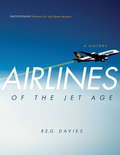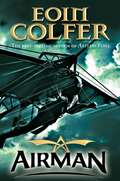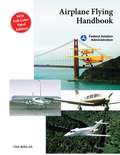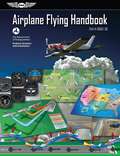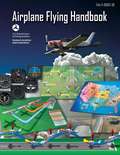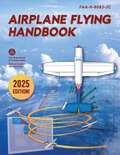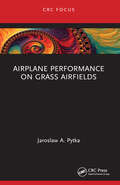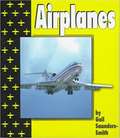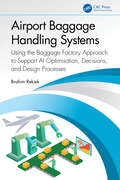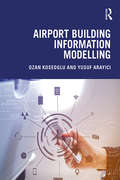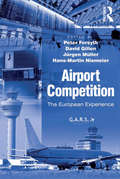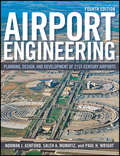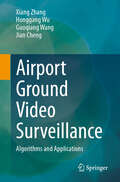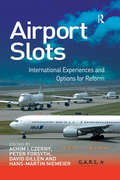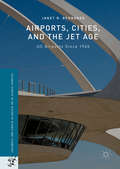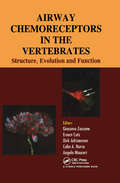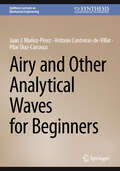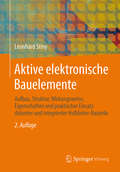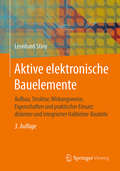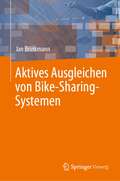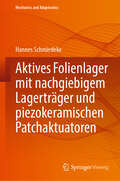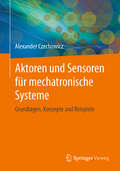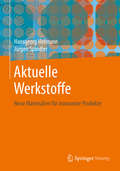- Table View
- List View
Airlines of the Jet Age: A History
by R.E.G. DaviesAirlines of the Jet Age provides the first comprehensive history of the world's airlines from the early 1960s to the present day. It begins with an informative introductory chapter on the infancy of flight and the development of air-transport craft used during the First and Second World Wars, and then wings into the "first" Jet Age--the advent of jet airlines. It continues through the "second" Jet Age of wide-bodied aircraft, such as the Boeing 747 and DC-10, and closes with the introduction of the "third" Jet Age, which begins with the giant double-decked Airbus A380. This reference book is an unparalelled reference for aviation buffs, covering airlines around the globe and throughout the modern eras of human flight. The last book written by renowned airline historian R.E.G. Davies, Airlines of the Jet Age is the ultimate resource for information and insight on modern air transport.
Airmail to the Moon
by Tom BirdseyeWhen the tooth that she was saving for the tooth fairy disappears, Ora Mae sets out to find the thief and send him "airmail to the moon!"
Airman
by Eoin ColferAt the dawn of the age of flight, Conor Broekhart is a boy living on the Saltee Islands off the Irish coast, where his father works as the king's bodyguard. But his happy, carefree life is changed forever when he finds out that the power-hungry Marshall Hugo Bonvilain is organizing a military coup to overthrow the king. When Conor is unable to stop Bonvilain, the king is murdered, and Conor is falsely accused of the crime and thrown into prison. In prison, the boy passes the solitary months by scratching designs for flying machines onto his cell walls. After two years, Conor is finally able to build a glider, and executes a daring escape to the mainland where he works to revenge himself on Bonvilain, save his family and the woman he loves..
Airplane Flying Handbook (FAA-H-8083-3A)
by Federal Aviation AdministrationThe Federal Aviation Administration’s Airplane Flying Handbook provides pilots, student pi-lots, aviation instructors, and aviation specialists with information on every topic needed to qualify for and excel in the field of aviation. Topics covered include: ground operations, cockpit management, the four fundamentals of flying, integrated flight control, slow flights, stalls, spins, takeoff, ground reference maneuvers, night operations, and much more. The Airplane Flying Handbook is a great study guide for current pilots and for potential pilots who are interested in applying for their first license. It is also the perfect gift for any aircraft or aeronautical buff.
Airplane Flying Handbook 2016 (FAA Handbooks)
by Federal Aviation Administration (FAA) StaffThe FAA's Airplane Flying Handbook has been required reading for all pilots for over 40 years, and introduces the basic pilot skills and knowledge essential for piloting airplanes. It benefits student pilots just beginning their aviation endeavors, as well as pilots preparing for additional certificates and ratings or who want to improve their flying proficiency, and flight instructors engaged in teaching pilots of all skill levels. This handbook provides information and guidance on the procedures and maneuvers required for pilot certification. Chapters are dedicated to ground operations, basic flight maneuvers, slow flight, stalls, spins, takeoff and departure climbs, performance and ground reference maneuvers, airport traffic patterns, approaches and landings, flight training basics, transitions to different types of aircraft, emergency procedures, and much more. The latest edition expands and updates the material that has always been a key reference in the FAA's testing and Airman Certification Standards (ACS), and it incorporates new areas of safety concerns and technical information such as loss-of-control upset prevention and recovery training, and transitioning to light sport airplanes (LSA). The Airplane Flying Handbook is the official FAA source for learning to fly and for many of the test questions in the FAA Knowledge Exams for pilots. Complete with chapter summaries and illustrated throughout with detailed, full-color drawings and photographs, it also includes a glossary and index.
Airplane Flying Handbook: FAA-H-8083-3B (FAA Handbooks Ser.)
by Federal Aviation AdministrationThe Federal Aviation Administration’s Airplane Flying Handbook provides pilots, student pilots, aviation instructors, and aviation specialists with information on every topic needed to qualify for and excel in the field of aviation. Topics covered include:Ground operationsCockpit managementThe four fundamentals of flyingIntegrated flight controlSlow flightsStallsSpinsTakeoffGround reference maneuversNight operationsAnd much moreUpdated to include the most current information, the Airplane Flying Handbook is a great study guide for current pilots and for potential pilots who are interested in applying for their first license. It is also the perfect gift for any aircraft or aeronautical buff.
Airplane Flying Handbook: FAA-H-8083-3C (2024) (Faa Handbooks Ser.)
by Federal Aviation AdministrationTHE DEFINITIVE GUIDE TO AIRPLANE FLYING, DEVELOPED BY FAA EXPERTS FOR USE IN 2024 AND BEYOND The Federal Aviation Administration&’s official publication, Airplane Flying Handbook provides pilots, student pilots, aviation instructors, and aviation specialists with information on every topic needed to qualify for and excel in the field of aviation. Topics covered include: Flight Training Ground Operations Basic Flight Maneuvers Energy Management: Mastering Altitude and Airspeed Control Maintaining Aircraft Control: Upset Prevention and Recovery Training Takeoffs and Departure Climbs Ground Reference Maneuvers Airport Traffic Patterns Approaches and Landings Performance Maneuvers Night Operations Transitions to Complex, Light-Sport, Multiengine, Tailwheel, and Turbopropeller- and Jet-Powered Airplanes Emergency Procedures Updated in 2021 with the most current information, including an all-new chapter on energy management, the Airplane Flying Handbook is a great study guide for current pilots and for potential pilots who are interested in applying for their first license. With full-color illustrations, photos, and diagrams detailing every chapter, this is a one-of-a-kind resource for pilots and would-be pilots. It is also the perfect addition to any aircraft or aeronautical enthusiast's library.
Airplane Performance on Grass Airfields
by Jaroslaw A. PytkaAirplane Performance on Grass Airfields presents an experiment-based approach to analysis and flight testing of airfield performance on grass runways. It discusses improvements for operations efficiency and safety of these airfields. The book analyzes the interaction between the landing gear wheels and the surface of a grass runways during both takeoff and landing. Considering the ground performance of an aircraft on a grass runway, the book covers test methods and devices for measuring performance and introduces an information system for the surface condition of grass airfields: GARFIELD. The system is based on a tire-grass interaction model and uses digital soil maps, as well as current meteorological data obtained from a weather server. The book is intended for researchers and practicing engineers in the fields of aviation and aircraft safety and performance.
Airplanes
by Gail Saunders-Smith"Summary: In simple text and photographs, describes several different kinds of airplanes, including paper airplanes, biplanes, and jets."
Airport Baggage Handling Systems: Using the Baggage Factory Approach to Support AI Optimisation, Decisions, and Design Processes
by Brahim RekiekThe competition between airports demands higher-quality services to satisfy passengers. A Baggage Handling System (BHS) serves functions such as baggage sorting, screening, and storage. A successful BHS means bags move between areas as travellers do. Handlers load/unload bags and transfer them between the airport's areas. Automation can save money and bring safety and operational benefits. Warehouses as well as the automotive industry are more advanced technologically in comparison to the airport and especially the baggage handling business. The concept of the Baggage Factory (BF) is an approach (based on Industry 4.0) that simplifies the processes from the moment passengers drop off their bags at check-in till the destination (chutes, carousels, and so forth). Airport Baggage Handling Systems: Using the Baggage Factory Approach to Support AI Optimisation, Decisions, and Design Processes introduces the features of the BF concept and presents how BHS designers can use AI technology to tackle many BHS problems and concerns. The book bridges the gap between airport BHS designers and experts in AI and optimisation. It describes in detail the field of baggage handling using algorithms for sorting bags or optimising the flow. The way the systems are designed is discussed, and a behind-the-scenes look at the BHS industry and how it affects the daily lives of travellers is presented. International and multidisciplinary in approach, this book is an ideal resource for practitioners, students, and researchers involved in the air transportation industry, Tourism, Systems Engineering, Layout and Design, Artificial Intelligence, Assembly Automation, and Logistics fields.
Airport Building Information Modelling
by Yusuf Arayici Ozan KoseogluThis book details how Building Information Modelling is being successfully deployed in the planning, design, construction and future operation of the Istanbul New Airport, a mega-scale construction project incorporating a varying mix of infrastructures including terminals, runways, passenger gates, car parks, railways and roads. The book demonstrates how Airport Building Information Modelling (ABIM) is being used to: • facilitate collaboration, cooperation and integrated project delivery • manage subcontractors and eliminate cost over-runs • reduce waste on site and enhance overall quality • connect people in a virtual environment to encourage collaborative working • provide clients with an effective interface for lifecycle management including: design development, construction documentation, construction phases and BIM and Big Data Integration for future facilities management The book presents a best practice BIM project, demonstrating concurrent engineering, lean processes, collaborative design and construction, and effective construction management. Moreover, the book provides a visionary exemplar for the further use of BIM technologies in civil engineering projects including highways, railways and others on the way towards the Smart City vision. It is essential reading for all Built Environment and Engineering stakeholders.
Airport Competition: The European Experience
by Peter Forsyth Jürgen Müller David Gillen Hans-Martin NiemeierThe break-up of BAA and the blocked takeover of Bratislava airport by the competing Vienna airport have brought the issue of airport competition to the top of the agenda for air transport policy in Europe. Airport Competition reviews the current state of the debate and asks whether airport competition is strong enough to effectively limit market power. It provides evidence on how travellers chose an airport, thereby altering its competitive position, and on how airports compete in different regions and markets. The book also discusses the main policy implications of mergers and subsidies.
Airport Engineering
by Norman J. Ashford Saleh Mumayiz Paul H. WrightFirst published in 1979, Airport Engineering by Ashford and Wright, has become a classic textbook in the education of airport engineers and transportation planners. Over the past twenty years, construction of new airports in the US has waned as construction abroad boomed. This new edition of Airport Engineering will respond to this shift in the growth of airports globally, with a focus on the role of the International Civil Aviation Organization (ICAO), while still providing the best practices and tested fundamentals that have made the book successful for over 30 years.
Airport Ground Video Surveillance: Algorithms and Applications
by Xiang Zhang Jian Cheng Honggang Wu Guoqiang WangThis book is the first overview book on video surveillance issues within airport grounds. It delves into the distinctive design principles underpinning computer vision algorithms tailored specifically for airport ground video surveillance, while also documenting the latest advancements within this domain. The initial section of this book introduces a comprehensive array of airport ground video surveillance datasets, encompassing the AGVS series alongside other pertinent datasets. Subsequently, the second section delves into the ongoing research endeavors on airport-ground-oriented computer vision algorithms, examining segmentation, recognition, and tracking methodologies. Lastly, the book’s third segment elucidates the design methodologies and exemplary use cases of airport ground video surveillance applications. Written by the authors intimately involved in creating the datasets, algorithms, and applications outlined within, this book stands as an indispensable reference for researchers and graduate students operating within the realm of intelligent transportation.
Airport Slots: International Experiences and Options for Reform
by Peter Forsyth Achim I. CzernyOver the past several decades, commercial air traffic has been growing at a far greater rate than airport capacity, causing airports to become increasingly congested. How can we accommodate this increased traffic and at the same time alleviate traffic delays resulting from congestion? The response outside the US has been to set a maximum number of slots and use administrative procedures to allocate these among competing airlines, with the most important consideration being 'grandfather rights' to existing carriers. The United States, on the other hand, has used administrative procedures to allocate slots at only four airports. In all other cases, flights have been handled on a first-come, first-served basis, with aircraft queuing for the privilege of landing or taking off from a congested airport. While recognizing the advantages of slot systems in lessening delays, economists have criticized both approaches as being sub-optimal, and have advocated procedures such as slot auctions, peak-load pricing and slot trading to better utilize congested airports. Edited by an international team of air transport economists and drawing on an impressive list of contributors, Airport Slots provides an extremely comprehensive treatment of the subject. It considers the methods currently used to allocate slots and applies economic analysis to each. The book then explains various schemes to increase public welfare by taxing or pricing congestion, and describes alternate slot-allocation schemes, most notably slot auctions. In addition, Airport Slots outlines the complexities involved in slot-allocation methods, including the requirement for multiple slots - a take-off slot at London Heathrow is useless unless there is a landing slot available at Frankfurt for a London Frankfurt flight. Finally, the book explores the economic pitfalls of slot-allocation schemes; for example, controls may not be required if external delay costs are internalized by a dominant carrier at its hub. Airport Slots provides a valuable contribution to the debate on how best to limit airport congestion. The book's comprehensive treatment of the subject matter provides the reader with a 'one-stop' volume to explore airport congestion and slot-allocation schemes, offering valuable insights to academics and practitioners alike.
Airports, Cities, and the Jet Age: US Airports Since 1945 (Palgrave Studies in the History of Science and Technology)
by Janet R. BednarekThis book explores the relationship between cities and their commercial airports. These vital transportation facilities are locally owned and managed and civic leaders and boosters have made them central to often expansive economic development dreams, including the construction of architecturally significant buildings. However, other metropolitan residents have paid a high price for the expansion of air transportation, as battles over jet aircraft noise resulted not only in quieter jet engine technologies, but profound changes in the metropolitan landscape with the clearance of both urban and suburban neighborhoods. And in the wake of 9/11, the US commercial airport has emerged as the place where Americans most fully experience the security regime introduced after those terrorist attacks.
Airship ROMA Disaster in Hampton Roads, The (Disaster)
by Nancy E. SheppardIn March 1921, Major John G. Thornell and his crew were detailed to Italy to procure a new experimental airship for the United States Army Air Service. Stationed at Langley Field in Hampton, the ROMA never lived up to expectations despite being heralded as the future of military innovation. Tragically, it crashed and erupted in a ball of fire in 1922, claiming the lives of thirty-four of the brave men aboard. Author Nancy E. Sheppard reveals the forgotten, harrowing story of one of the last great airships and those who sacrificed for the promise of a new era in aviation.
Airway Chemoreceptors in Vertebrates
by Dirk Adriaensen Colin A. Nurse Giacomo Zaccone Ernest Cutz Angela MauceriThis book provides a comprehensive and up-to-date account of the information available on the morphological, physiological and evolutionary aspects of specialized cells distributed within the epithelia of the airways in the vertebrates. A lot of work has been done on the cell and molecular biology of these cells which are regarded as as oxygen receptor neuroepithelial cells. These chemoreceptors which were conserved throughout evolution have neuroendocrine functions carrying their signals to the central nervous system. The chemoreceptor cells are sensors which detect the signal changes in the external and internal environments, and play a key role in the survival of various species. Studies addressed to the chemoreceptor cell systems in the airways are of great importance for investigating their response to changes in the oxygen and carbon dioxide concentrations in the environment since the future of the planet earth is being threatened by global warming and climate change. Praise for the book: ...This volume would be of special interest to researchers who are curious about the evolution of vertebrate respiratory control in general and the regulation of ventilation in nonmammalian vertebrates in particular. -Wayne L. Silver, Wake Forest University, in The Quarterly Review of Biology, Volume 85, Number 2
Airy and Other Analytical Waves for Beginners (Synthesis Lectures on Mechanical Engineering)
by Juan J. Muñoz-Perez Antonio Contreras-de-Villar Pilar Diaz-CarrascoThe aim of this book is to become something practical, providing a description of the essential theory (explained simply) and many solved exercises. The basic concepts necessary to understand the rudiments of the Airy wave and other analytical waves (and their application to Coastal Engineering) are clarified. Moreover, the appropriate mathematical tools are given in certain cases because some science courses do not require a minimum background in mathematics or physics. Despite not going into depth into the theoretical developments, experience has demonstrated that students are ensured to acquire the bare minimum of knowledge necessary to pursue any subsequent improvement course.
Aktive elektronische Bauelemente: Aufbau, Struktur, Wirkungsweise, Eigenschaften und praktischer Einsatz diskreter und integrierter Halbleiter-Bauteile
by Leonhard StinyDas Werk bietet ein umfangreiches Wissen #65533;ber diskrete und integrierte Bauelemente der Halbleitertechnik. Beim Entwurf elektronischer Schaltungen sind gr#65533;ndliche Kenntnisse #65533;ber eingesetzte Bauelemente erforderlich, um sowohl technisch als auch wirtschaftlich beste L#65533;sungen zu finden und fehlerfreie Produkte zu realisieren. Als Basis werden die theoretischen und physikalischen Grundlagen der Halbleitertechnik vermittelt. F#65533;r alle Halbleiter-Bauelemente werden Aufbau, Wirkungsweise, Kenngr#65533;#65533;en, Eigenschaften und Charakteristiken erl#65533;utert. M#65533;gliche Anwendungen werden unter Bezug auf die Praxis aufgezeigt. Das Buch kann im Studium, in der Lehre sowie als Nachschlagewerk in der Praxis verwendet werden.
Aktive elektronische Bauelemente: Aufbau, Struktur, Wirkungsweise, Eigenschaften und praktischer Einsatz diskreter und integrierter Halbleiter-Bauteile
by Leonhard StinyDas Werk bietet ein umfangreiches Wissen #65533;ber diskrete und integrierte Bauelemente der Halbleitertechnik. Beim Entwurf elektronischer Schaltungen sind gr#65533;ndliche Kenntnisse #65533;ber eingesetzte Bauelemente erforderlich, um sowohl technisch als auch wirtschaftlich beste L#65533;sungen zu finden und fehlerfreie Produkte zu realisieren. Als Basis werden die theoretischen und physikalischen Grundlagen der Halbleitertechnik vermittelt. F#65533;r alle Halbleiter-Bauelemente werden Aufbau, Wirkungsweise, Kenngr#65533;#65533;en, Eigenschaften und Charakteristiken erl#65533;utert. M#65533;gliche Anwendungen werden unter Bezug auf die Praxis aufgezeigt. Das Buch kann im Studium, in der Lehre sowie als Nachschlagewerk in der Praxis verwendet werden.
Aktives Ausgleichen von Bike-Sharing-Systemen
by Jan BrinkmannDieses Buch berichtet über einen Betriebsmanagementansatz zur Verbesserung von Bike-Sharing-Systemen durch den Ausgleich von Nachfrageschwankungen. Ziel ist es, die Fahrräder innerhalb des Systems umzuverteilen und so ein "aktives" Gleichgewicht herzustellen. Das Buch beschreibt ein mathematisches Modell sowie datengesteuerte und simulationsbasierte Ansätze. Außerdem wird gezeigt, wie diese Elemente in einem System zur Entscheidungsunterstützung für Dienstleistungsanbieter kombiniert werden können. Abschließend wird die entwickelte Methode anhand von realen Daten evaluiert und gezeigt, dass sie erfolgreich Nachfrageänderungen vorhersehen kann und somit eine effiziente Planung von Transportfahrzeugen für die manuelle Verlagerung von Fahrrädern zwischen Stationen unterstützt.
Aktives Folienlager mit nachgiebigem Lagerträger und piezokeramischen Patchaktuatoren (Mechanics and Adaptronics)
by Hannes SchmiedekeFolienlager sind Gleitlager mit einer nachgiebigen Innenkontur. Dies erlaubt die Kompensation der fliehkraft- und temperaturbedingten Wellenexpansion bei hohen Drehzahlen. Die vielen Reibkontakte zwischen den Folien erhöhen zudem die Lagerdämpfung. Mit aerodynamisch wirkenden Folienlagern ausgestattete Turbomaschinen können somit je nach Baugröße mit mehr als 100.000 U/min betrieben werden. Ein wesentlicher Faktor, der die Lebensdauer begrenzt, ist der Verschleiß bei jedem Start-Stop-Zyklus. Unglücklicherweise können Folienlager geometrisch entweder auf einen geringeren Verschleiß beim Anfahren oder eine größere Stabilität bei hohen Drehzahlen optimiert werden. In dem hier vorliegenden Buch wird daher der Ansatz eines aktiv schaltbaren Folienlagers vorgestellt, bei welchem das Lagerspiel und die geometrische Vorspannung (Preload) je nach Betriebszustand eingestellt werden können. Anhand theoretischer Überlegungen und experimenteller Beobachtungen zeigt sich eine grundsätzliche Eignung der im aktiven Lager angestrebten Schaltformen. So ist trotz signifikanter Einflüsse von Fertigungs- und Montageabweichungen eine Verbesserung des Anfahrverhaltens bzw. ein stabiler Betrieb bei hohen Drehzahlen sichtbar. Die Integration der aktiven Komponente, bestehend aus den piezokeramischen Patchaktuatoren und einem geometrisch an eine dreiflächige Lagerbuchse angelehnten Lagerträger, verändern das Betriebsverhalten gegenüber der passiven Prototypen dabei aber erheblich. So verringert sich neben der Lagersteifigkeit auch die Lagerdämpfung. Zudem genügen moderate Lasten und fertigungsbedingte Eigenspannungen, um die aktive Verformung des Lagerträgers zu blockieren. Theoretische Modelle zeigen, dass eine Versteifung der aktiven Komponente durchaus zielführend ist. Eine praktische Umsetzung ist hingegen aufgrund fehlender Aktuatorwerkstoffe aktuell noch nicht möglich.
Aktoren und Sensoren für mechatronische Systeme: Grundlagen, Konzepte und Beispiele
by Alexander CzechowiczAktoren und Sensoren sind Kernbestandteile moderner mechatronischer Systeme. Eingebettet zwischen einer mechanischen Grundstruktur und einer Informationsverarbeitung bilden Aktoren und Sensoren die Brücke zwischen einer modernen digitalisierten Anwendung in der Industrie 4.0 und der realen Maschinenmechanik. Dieses Lehrbuch stellt die Grundlagen mechatronischer Systeme zusammen und gibt einen detaillierten Überblick über industriegebräuchliche sowie neuartige Aktoren, Sensortechnologien, Informationsverarbeitungssysteme und Anwendungskonzepte der Industrie 4.0. Zusätzlich fasst das Buch Methoden der numerischen Modellbildung von ausgewählten Aktoren und Sensoren zusammen und zeigt diese in Beispielszenarien einiger mechatronischer Anwendungen.
Aktuelle Werkstoffe: Neue Materialien für innovative Produkte
by Hansgeorg Hofmann Jürgen SpindlerDieses Buch führt Sie in die aktuellen Werkstoffentwicklungen der Schlüsseltechnologien ein. Daneben sensibilisieren die Autoren für Energieeffizienz, Erhaltung der Umwelt und Ressourcen sowie Sicherung der Lebensqualität. Erhalten Sie einen Überblick über aktuelle Trends der Werkstoffentwicklung und konkrete Anwendungsmöglichkeiten. Ausgewählte Themenkreise und Beispiele erläutern die Bedeutung der Werkstoffforschung für den technischen Fortschritt. Der Fokus auf die naturwissenschaftlichen Grundlagen hilft Ihnen dabei, die Entwicklung und die Eigenschaften neuer Werkstoffe zu verstehen. Außerdem geben Ihnen die Verfasser Impulse zur Erschließung neuer Anwendungsgebiete der Werkstoffentwicklung. Neue Materialien für innovative Produkte zu finden, ist eines der wichtigsten Themen in der Werkstoffentwicklung, da die Potenziale klassischer Werkstoffgruppen ausgeschöpft sind. Deswegen erläutern die Autoren zunächst die Eigenschaften aktueller Werkstoffe, ehe sie zeigen, wie man diese Eigenschaften durch neue Fertigungsverfahren, die Nanotechnik oder Veränderungen der Morphologie beeinflusst und verändert. Entdecken Sie, wie Sie auch durch Eingriffe in die chemischen und physikalischen Vorgänge in Werkstoffe neue Eigenschaften herausbilden. Das Buch verknüpft gekonnt die Theorie und Praxis der Werkstoffentwicklung. Erfahren Sie alles über Energiewandlung, Fertigungstechniken und aktuelle Entwicklungen in der Transport- und Verkehrstechnik. Eine Leseempfehlung für Ingenieure, deren Fokus im Fertigungsbereich liegt und technikinteressierte Laien, die mehr über aktuelle Werkstoffe erfahren möchten.
